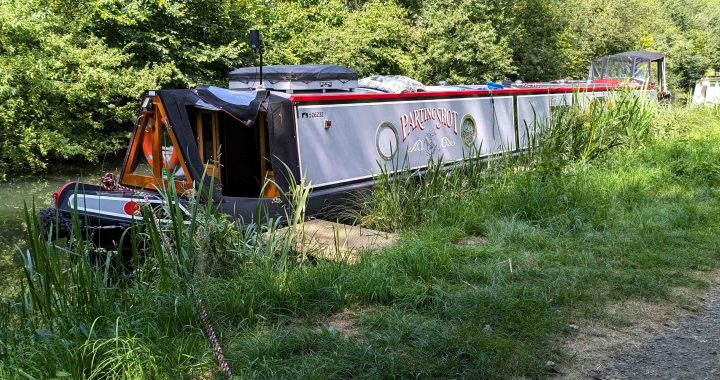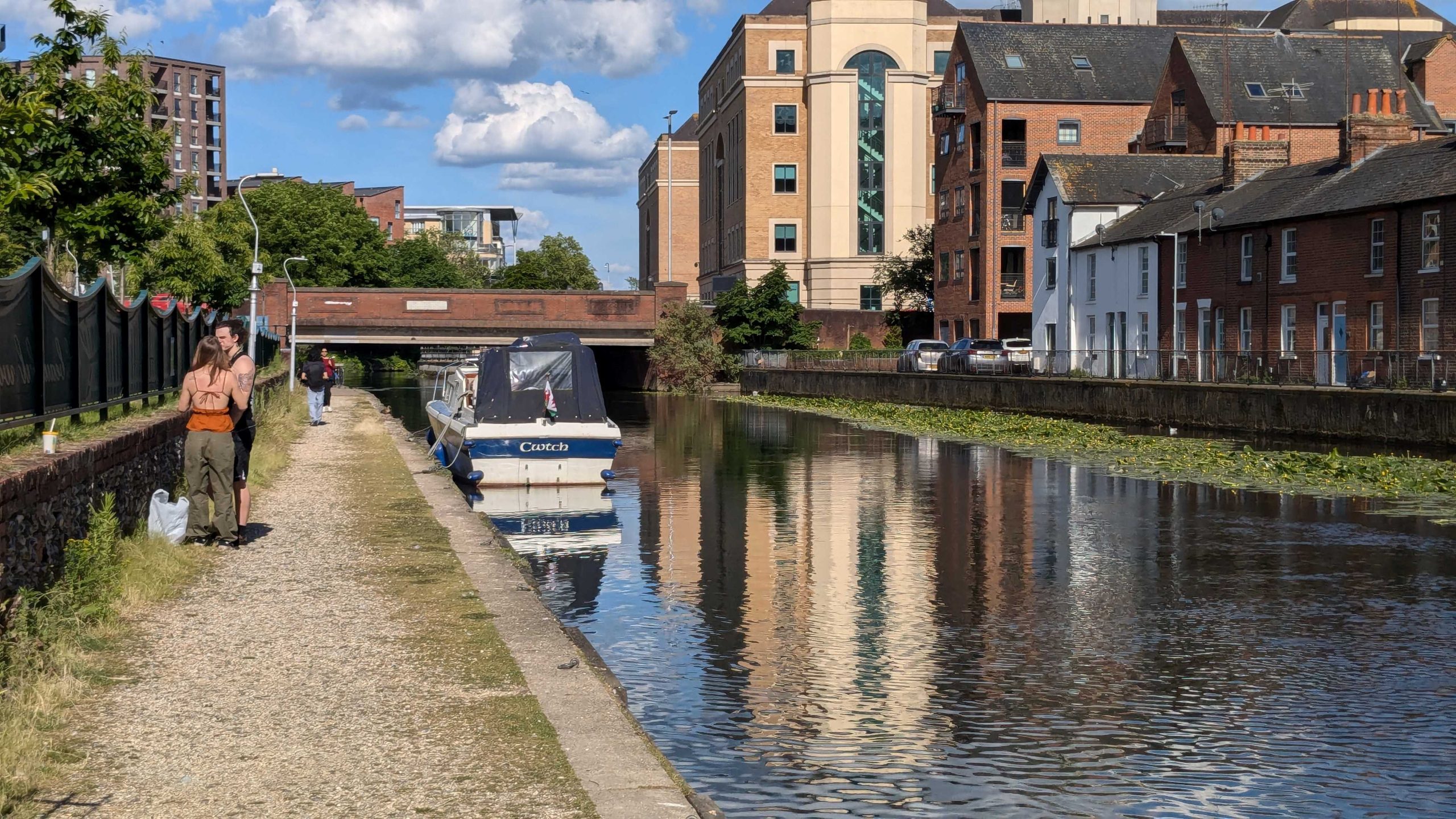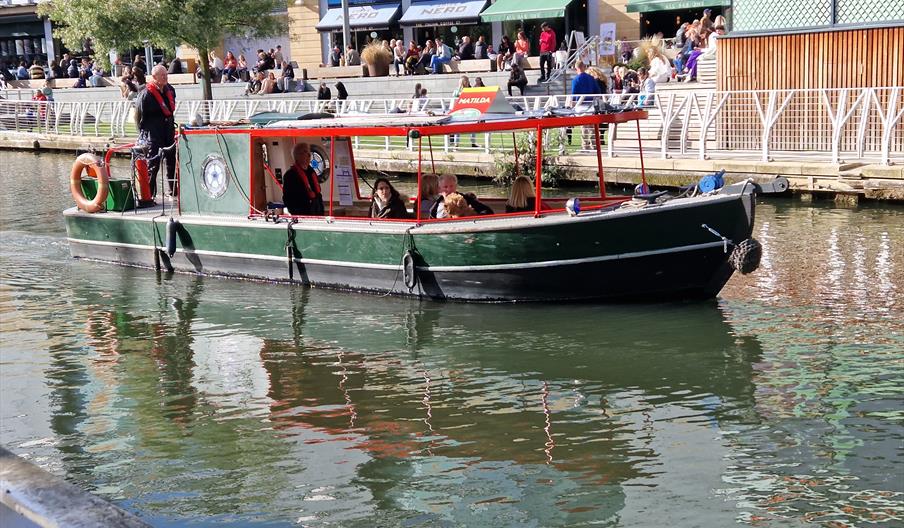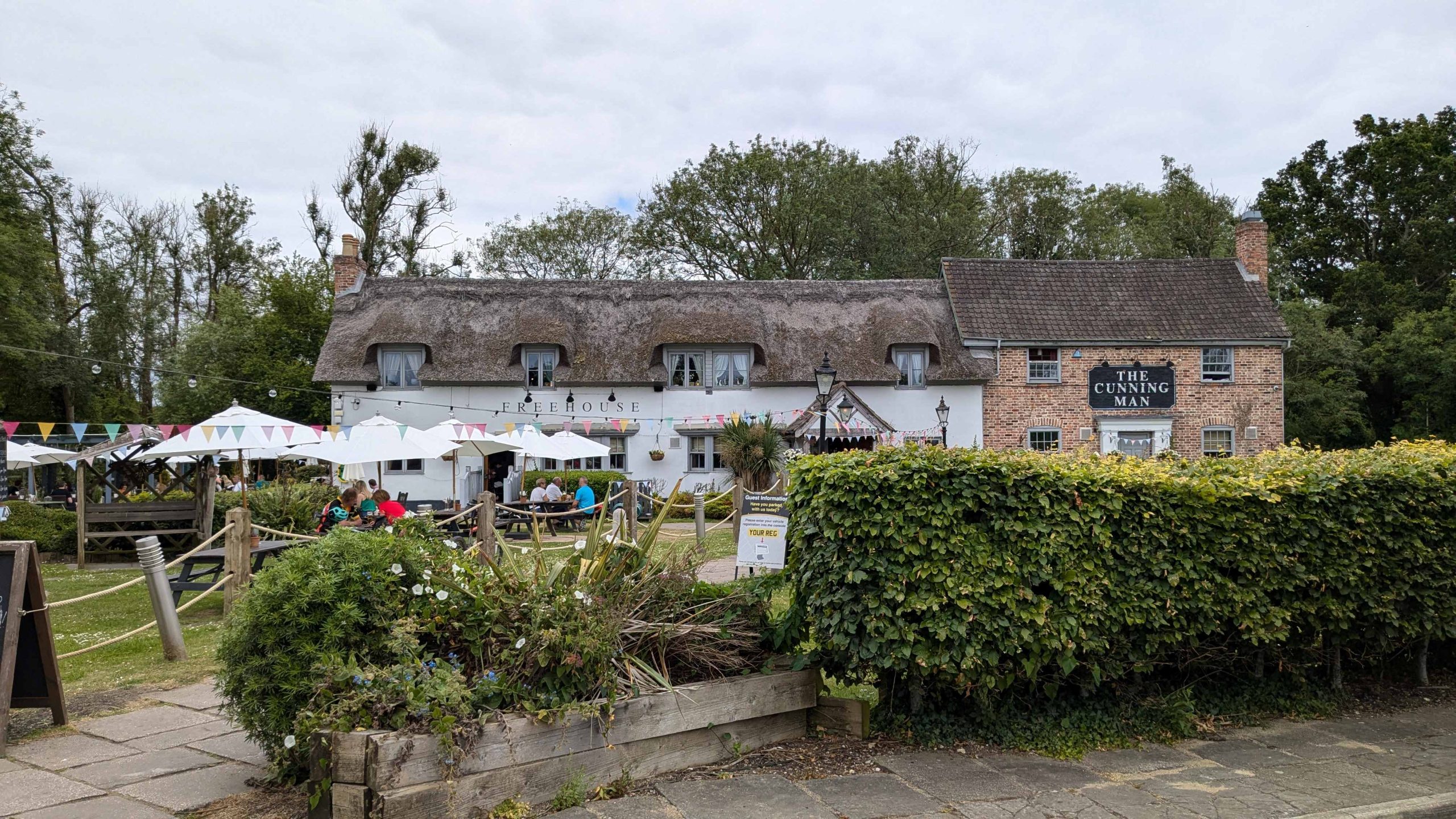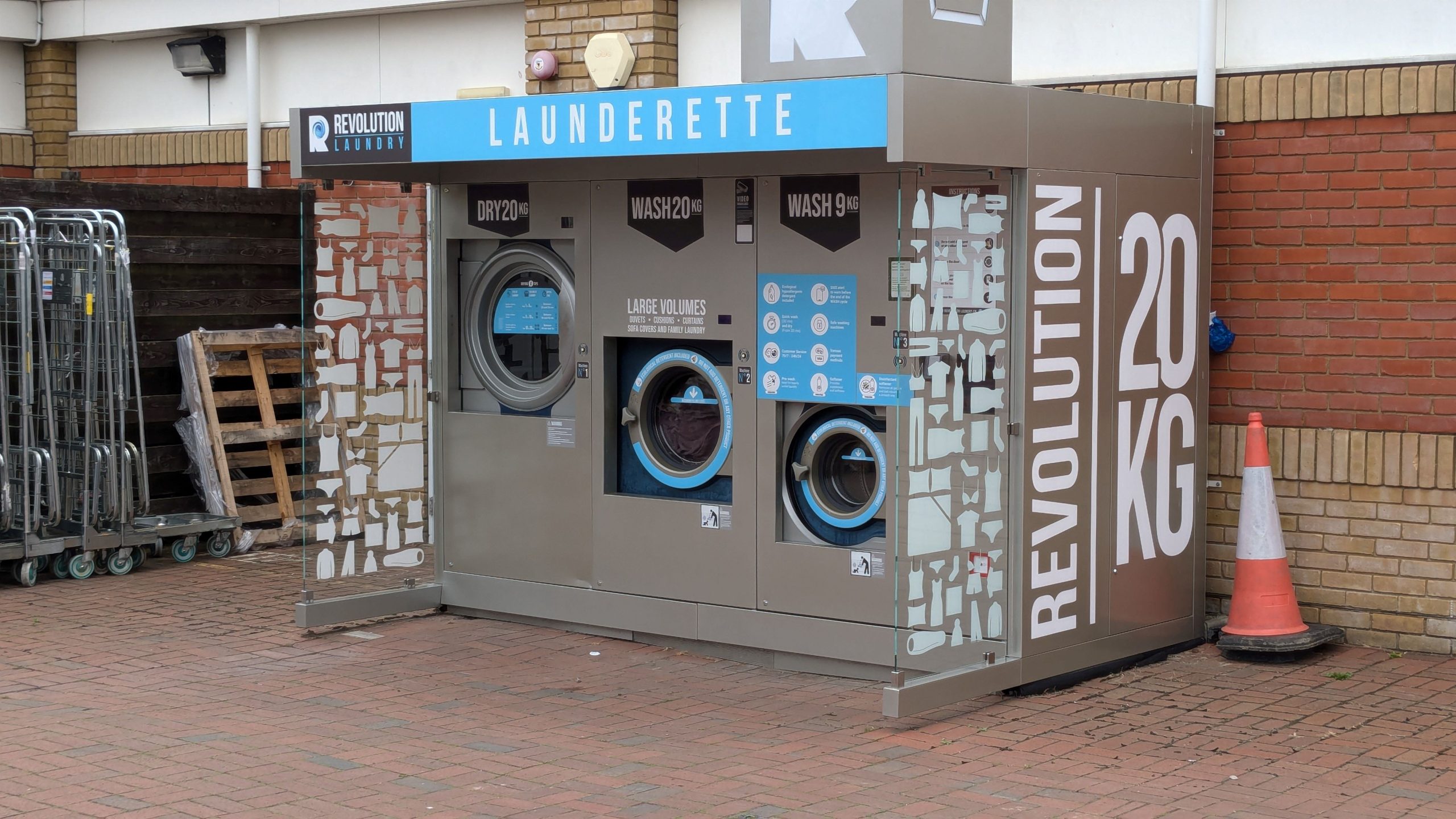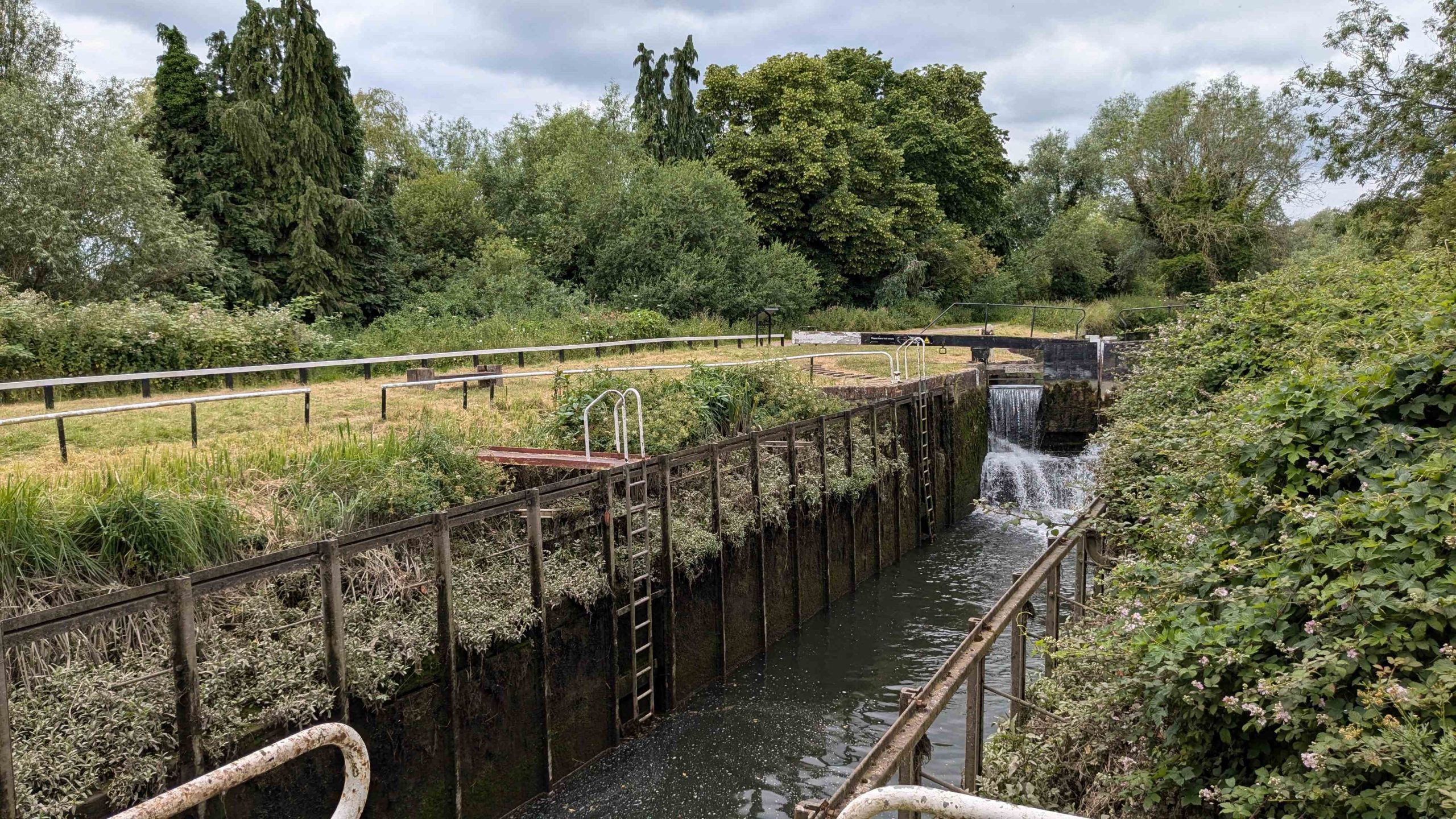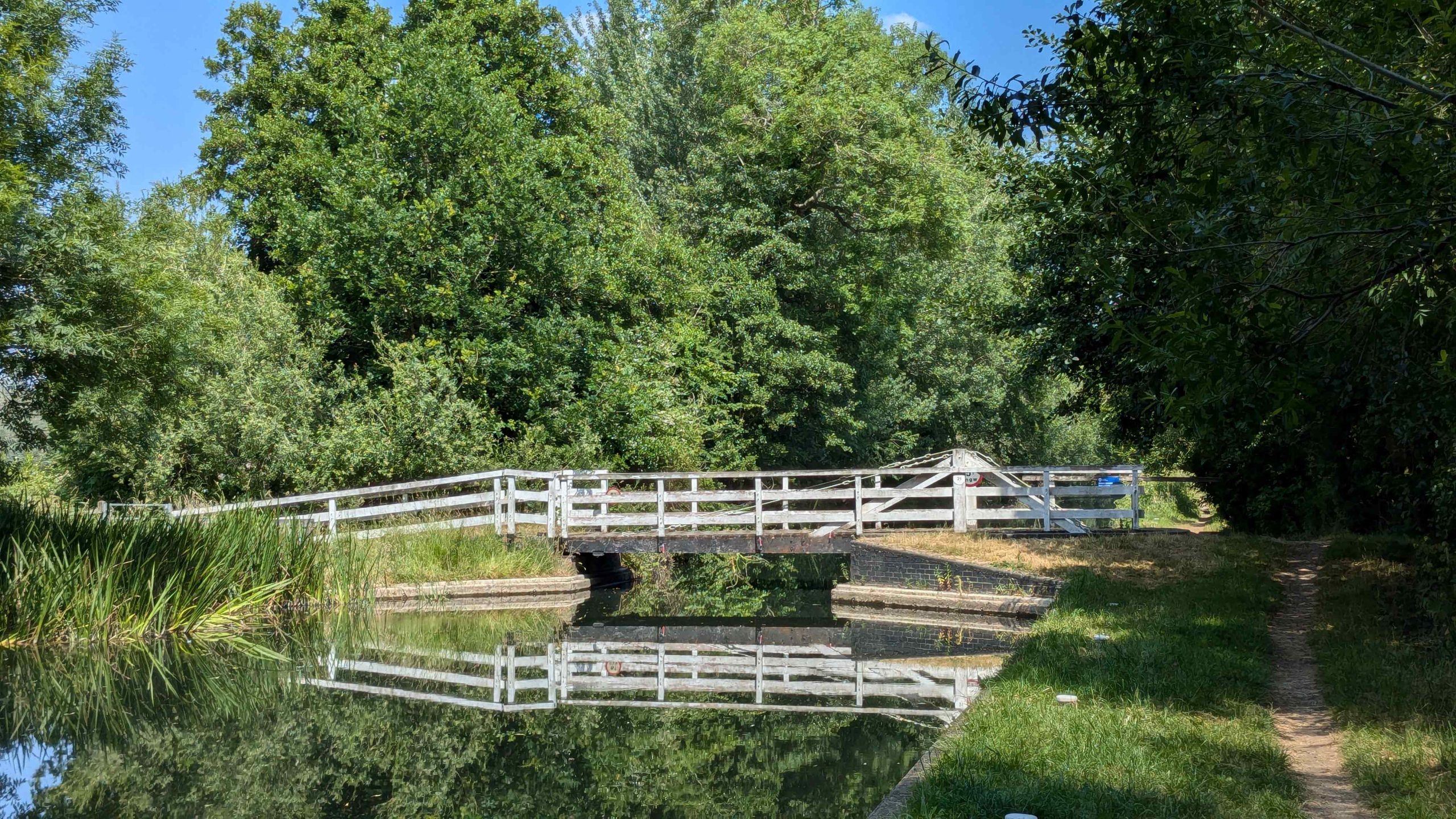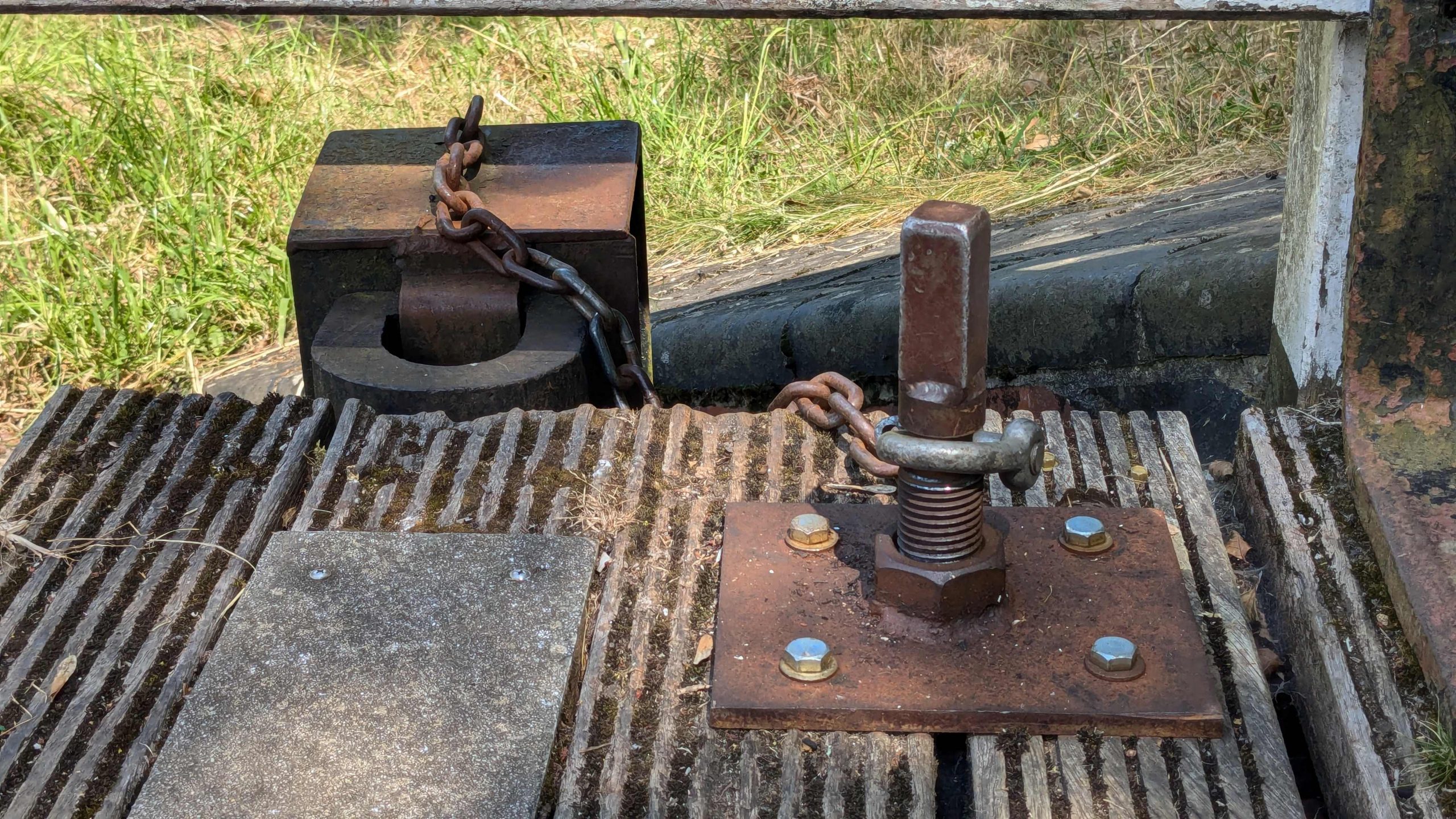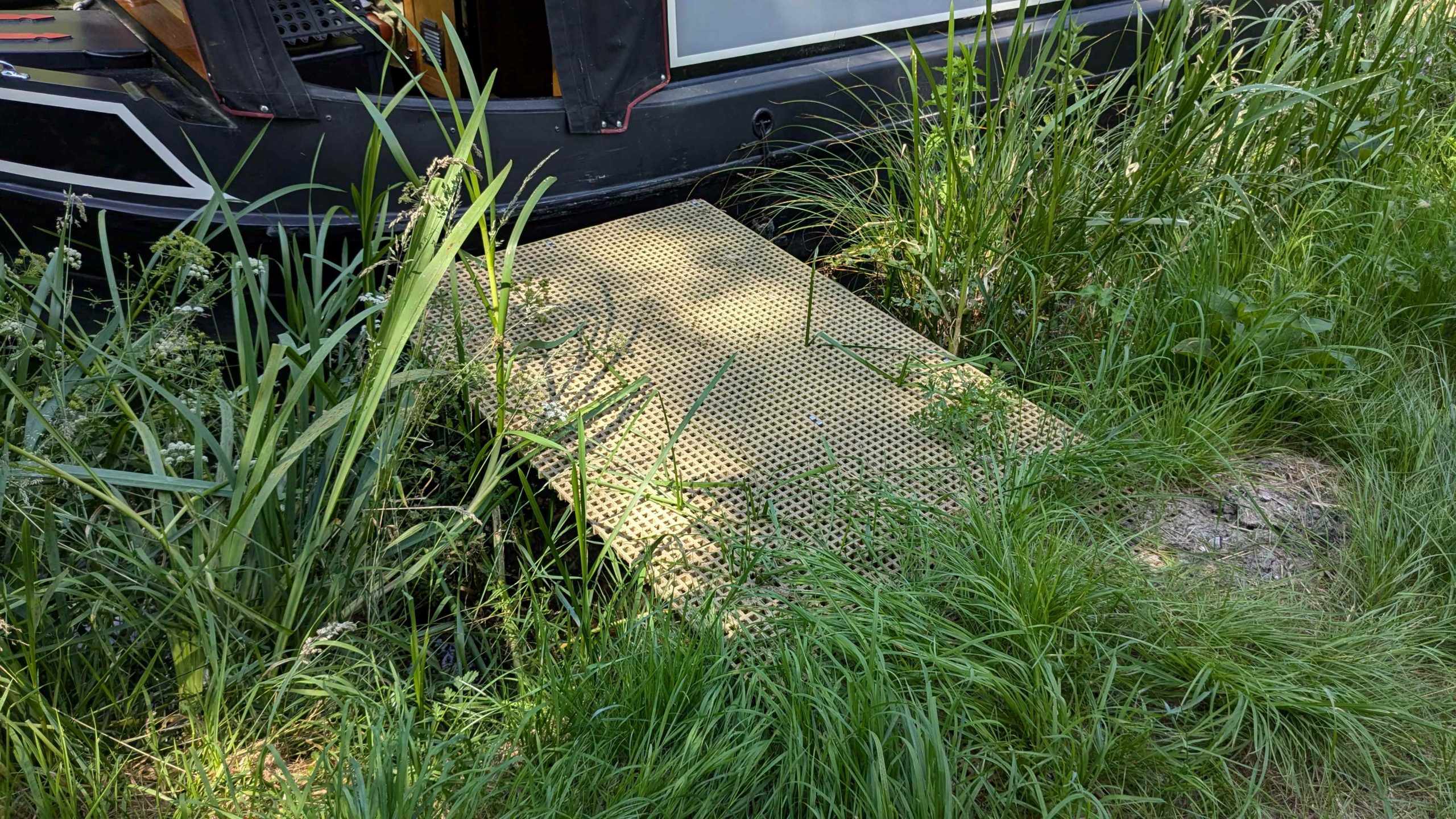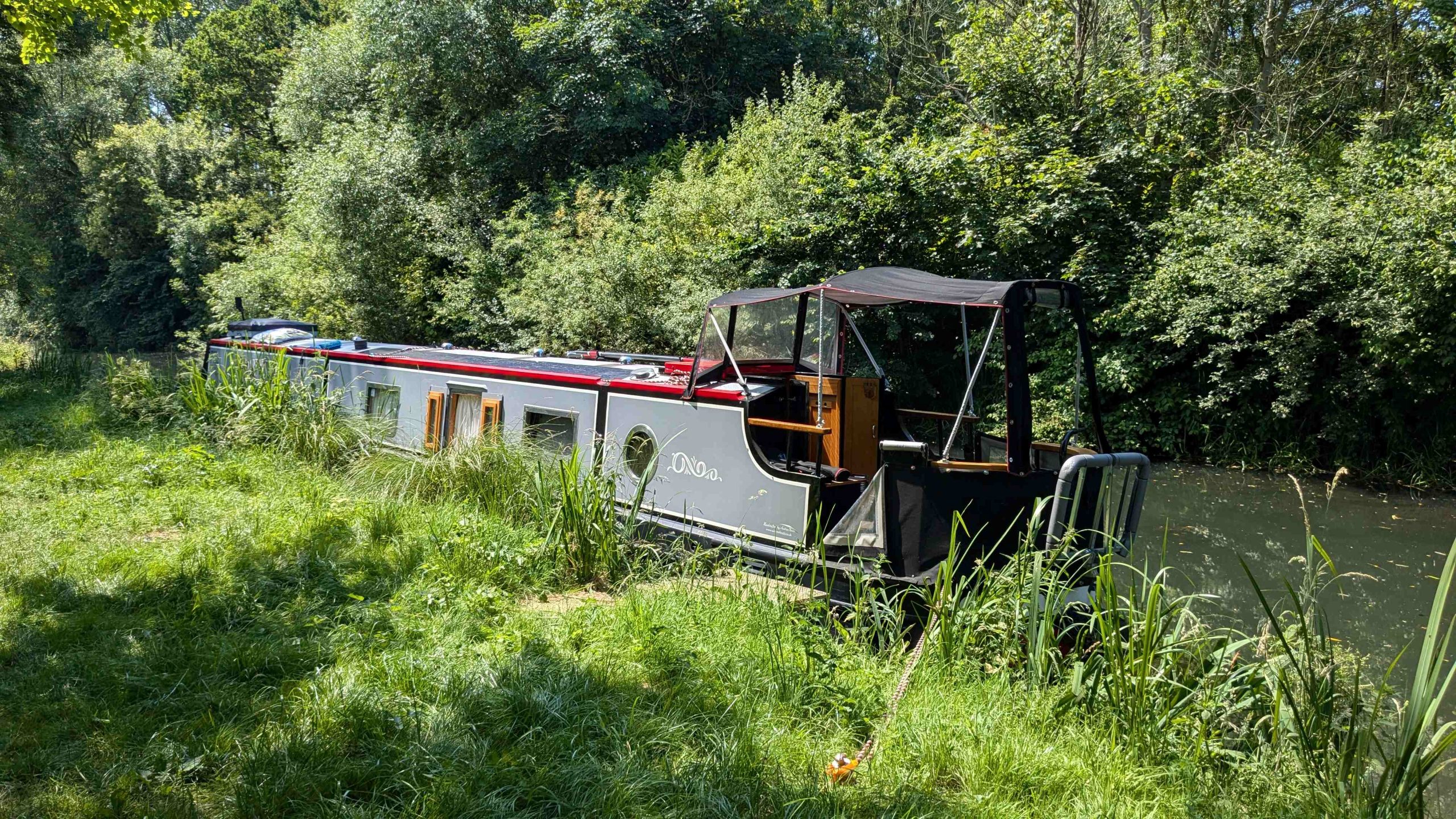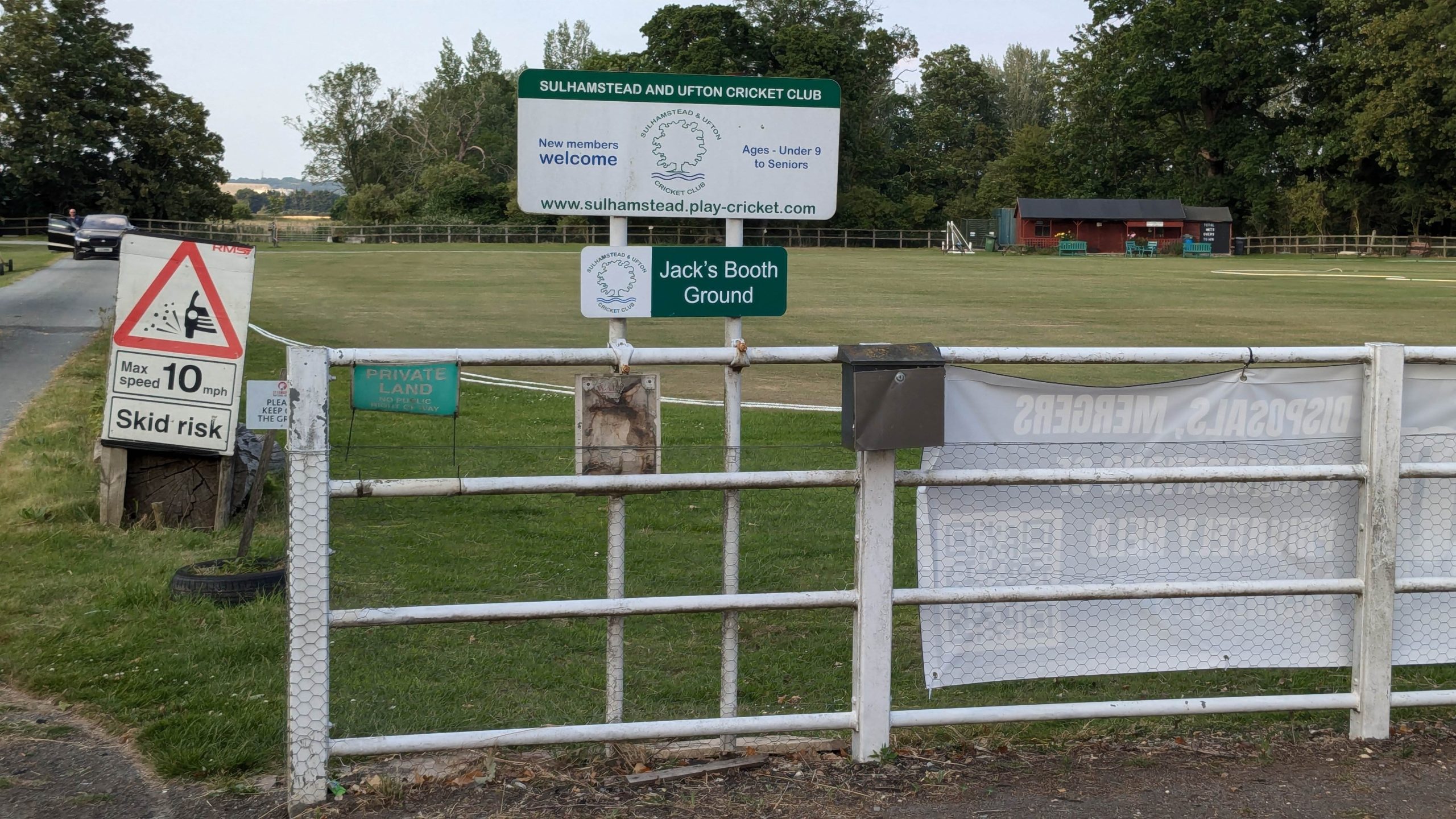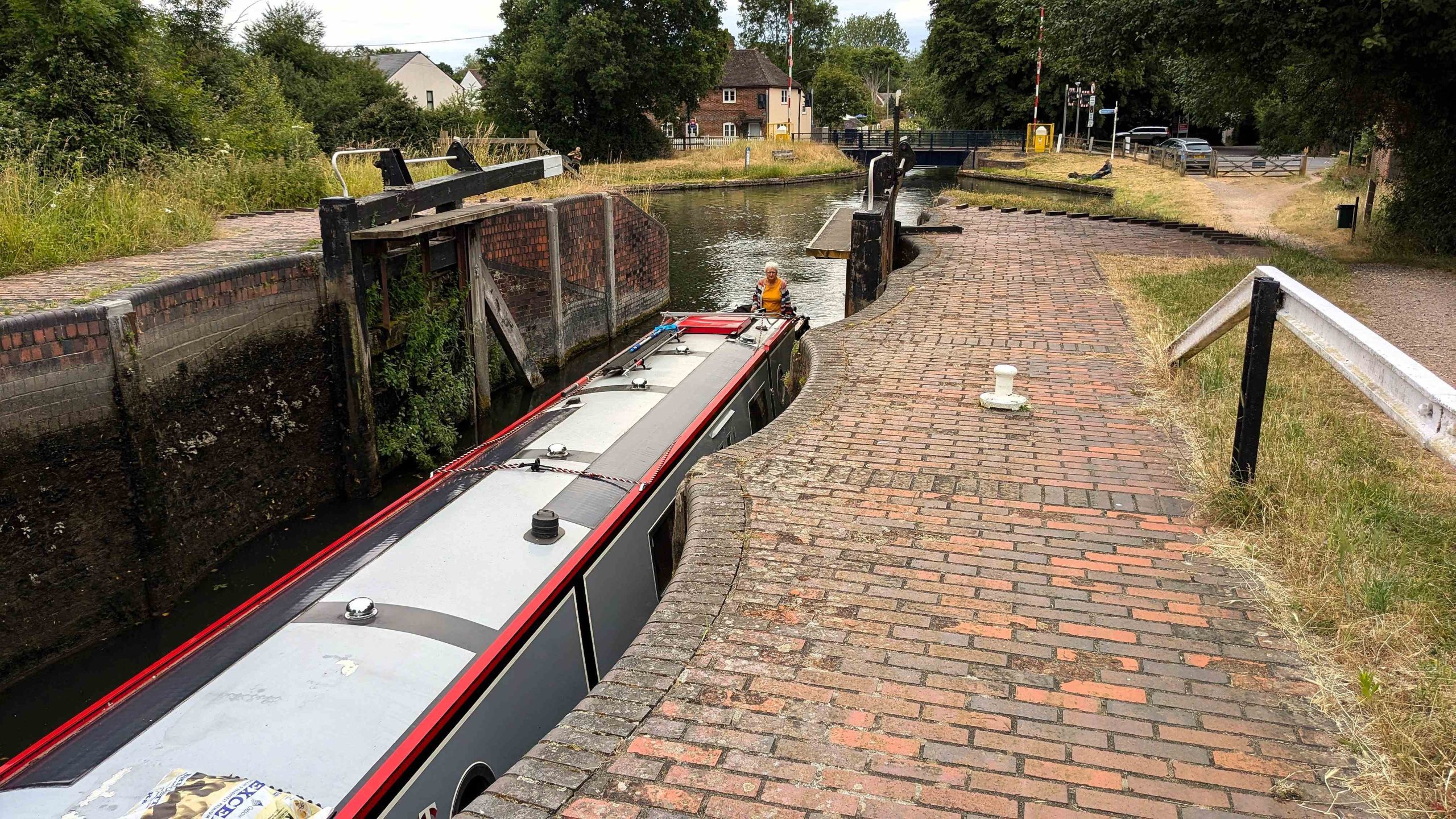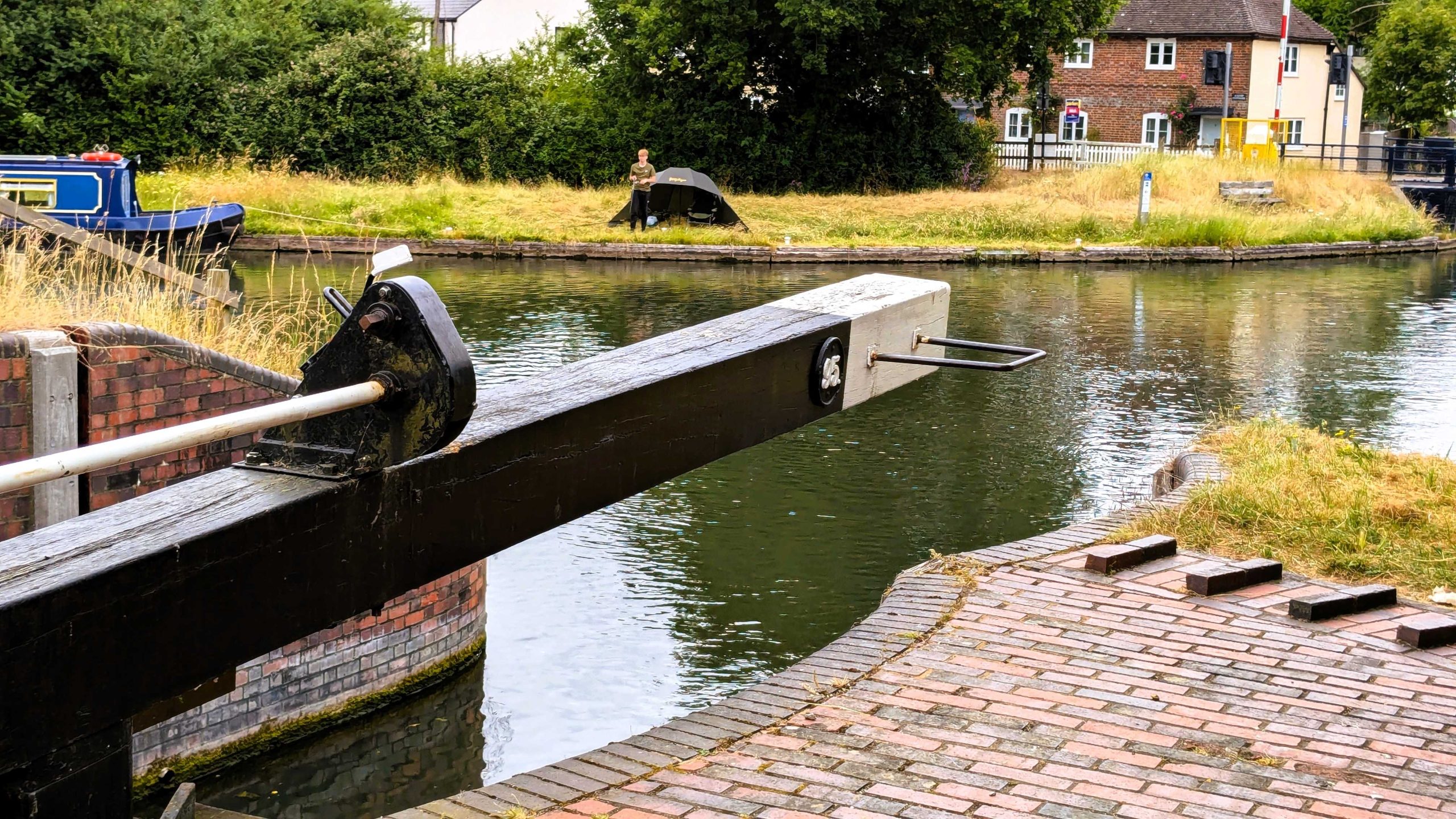Reading On
The Kennet & Avon canal is not actually a simple man-made canal. In joining the Port of Bristol to the River Thames it is actually made up of three distinct waterways: the River Avon from Bristol to Bath, a largely man-made canal section from Bath to Newbury and the River Kennet from Newbury to Reading. The latter section, in particular, has frequent changes from river to canal sections working to straighten and shorten the route. Where possible, the navigation uses the river, elsewhere, the meanders of the the Kennet enter and leave the canalised sections as they criss-cross the new route. The cross currents created can be quite dangerous and with any significant rainfall, levels in the river sections can rise a great deal, very quickly. They often go onto red boards and are closed to navigation, sometimes for very long periods over the winter and spring months.
As we entered the Kennet from Reading the first thing to become apparent was that I had, quite unconsciously, got completely the wrong end of the stick. We had been coming steadily downstream along the Thames from Lechlade and without really thinking about it, I had somehow just assumed that if we were in the centre of the country, heading towards the sea, we would continue to be going downstream. In fact, we found ourselves pushing upstream against quite a strong current. It took a minute or two to adjust to the reality, increasing the engine revs to counter the flow and anticipating its effect when approaching the landing at Blake's Lock. The navigation actually continues to rise all the way to Wootton Rivers, some forty miles further on.
We had been concerned about finding a suitable mooring right here in Reading but yesterday's reconnaissance had uncovered a pedestrian backwater behind the Abbey, called Chestnut Walk, which was perfect.
Plenty of space for several boats with mooring rings to tie up to, open to the sun and very quiet, with good separation between the mooring and the walkway. The only snag was the approach, which involved a couple of tight turns, fully in the strong current from the weir at Blake's Lock and then the, very low, Gas Works Road Bridge on the way. Yesterday I had found only "Cwtch", a small cruiser, moored here. The owner was new to boating life and was lamenting his broken windscreen and frame that, unaware of the height restriction, he had shattered coming under this bridge.
Forewarned is forearmed and having taken down anything we thought might be too high before leaving, we had no issues, mooring up comfortably before lunch. "Cwtch" was still here but left abruptly when a warden came round to check on payment for the mooring. He needed to turn round and leave via the other end of the loop to avoid more damage from the bridge. In doing so, he seemed to lose steering and we had an interesting few minutes taking a line and trying help him turn round. He managed it in the end and spluttered off toward the main line but he was on a steep learning curve and I suspected we would see him again.
We were a short walk from the car park and Sue went with Jen to do a major grocery shop at the big Sainsbury's out of town before we left civilization behind. I took Archie and went to explore further up the river to get a feel of what was to come and where we might moor next. On the way I passed County Lock and found "Cwtch" in the lock going up, while "Matilda Too", a trip boat run by the Kennet and Avon Trust, was trying to enter the lock to go down.
After a bit of jostling the trip boat backed out onto the tiny landing stage and "Cwtch" was able to leave the lock. I did ask one of several trust volunteers, standing by to help, why the trip boat had been trying to enter. His honest answer was that he had no idea what the skipper had been thinking of. Perhaps she had thought that, as "Matilda Too" was a narrowboat, they might be able pass side by side but the cruiser was pretty wide and it was clearly a non-starter.
Fobney Lock
The mooring in Chestnut Walk was as pleasant and peaceful as it had promised but was only good for twenty-four hours. We had arranged to meet Jen and Elsie one last time, so that she could whisk us off to lunch before she set off for home. I had spotted a place to moor up, that was accessible by road, just beyond County Lock, so only about half a mile along the main line. An interesting half mile, though. It starts by requiring a boat to pull over and push a traffic signal button and wait for a green light, just like a pelican crossing. This controls traffic along a stretch that, while not overly narrow, has several tight, blind bends along it. It runs through the heart of a huge area of bars and restaurants, for which the canal is, no doubt, intended to be an attractive feature. Emerging from the restricted section brings you to County Lock, itself, which has a wide, fierce weir beside it and very short, tricky landing stages.
We met up as planned and even though road closures sent us several miles out of our way we had a very nice lunch in the sun at a pub called "The Cunning Man", which suddenly made sense of what a passing boater had shouted to us about where he had moored the previous night.
We weren't particularly keen on spending the night where we had left the boat earlier so, as soon as Jen had dropped us off, we headed off up to Fobney Lock, which proved to be quite challenging. We had a little battle with the fierce outflow from the water works that came straight onto the lower lock landing. The lock was being used as a swimming pool by a group of youngsters but they moved out of the way willingly enough and then were happy to help open and shut the gates. A couple of guys in their twenties also turned up on bicycles with a portable speaker blasting out rap music but again, they proved very helpful as they were familiar with the lock and helped to 'crack' it open when the top gates wouldn't quite equalise, apparently a regular problem here. This turned out to be quite a typical condition of the big, heavy locks on the Kennet & Avon.
There were a couple of very large boats, breasted up together, blocking the lock landing, with a CRT barge just behind. We managed to get past and found mooring for ourselves a little further down. Down at the lock it turned into quite the social gathering as the deck chairs came out, set up on the work boat, accompanied by another portable speaker and a barbecue. It seemed likely that this had been a regular evening event while the weather had been fine.
Although there was a lot of work going on to improve and repair the towpath, which meant plant going up and down during the day, it was quiet the rest of the time and beside this stretch was a nature reserve with plenty of wildlife. On the other hand, Sue could walk to the supermarket from here. We stayed for a couple of days, exploring the area and doing some maintenance chores. Then we realised this had taken us through the longest day and that from now on, we could expect to see the nights drawing in.
A Weekend At Burghfield
On Saturday, twenty-second June, we decided it was time to move on. We made it about a mile and a half, through one lock, to end up, about an hour later, at Burghfield Bridge, right back beside The Cunning Man. A short run but enough to confirm that the heavy locks and strong currents along and across the navigation were a significant factor and made this a different type of cruising to 'normal' canals.
Just beyond the bridge and the pub itself, there was a stretch of fairly straight bank, more or less deep enough to get into the side and not as badly overgrown as elsewhere and we were able to find a space there.
We still had over a week to go before we were due to go into Froud's Bridge Marina and head off to fulfil our babysitting commitment. As the marina was less than five hours cruising away we needed to take our time, so we would have to make few, very short, moves over the next few days.
To start with, we stayed by the Cunning Man for the weekend. Apart from the pub itself the discovery of a 'Revolution' automatic laundrette at the nearby M4 service station was an exciting opportunity. The bedding and towels are too much for our on-board washing machine, so we could take them up there and let them spin while we had some junk food for lunch. It went so well on Saturday that we had to go back again on Sunday afternoon!
Although we had feared the weather might be breaking down it actually stayed quite fine. As the wetland along both sides of the navigation prevents even the most foolhardy developer proposing new building projects, it provides a useful buffer to keep the local towns at arm's length and afforded some nice walks to explore wherever we stopped.
On Monday we moved up three locks and about two and a half miles to Sheffield Bottom Swing Bridge. We got some help from a passer-by with Burghfield Lock, which proved extremely difficult to equalise. The second one, Garston Lock, was one of the last two working turf locks on the Kennet & Avon. The sides are sloping banks of earth and vegetation, instead of the normal vertical brick and stone. As a result there is no lock side to walk around by the boat, just open guard rails to keep the boat in the channel once the water level rises.
We found it quite dangerous to operate with and they must be particularly tricky for a single-handed boater. Now, of course, with all the others replaced, these two are listed structures so it will be very difficult to make any changes.
Arriving at the two day mooring beyond the swing bridge it was not a surprise, if a little frustrating, to find that the visitor mooring itself was occupied by boats that we knew had been there for weeks. We were able to find a less overgrown stretch of bank a couple of hundred yards farther on. We got close enough to get some pins in and to put out the gangplank to bridge the gap but it wasn't ideal. One night of that was enough, though. We were close enough to Theale for Sue to go up and do some shopping the next morning but then we moved on for a whole mile and a half to Tyle Mill.
On the way, we encountered a swing bridge with a strange locking mechanism and it took a moment to figure it out. The chain to prevent it opening was attached to a huge bolt that was screwed into a correspondingly large nut bolted to the bridge deck.
We saw a lot of these in the next few weeks and we realised the bolt was supposed to be unwound with a standard windlass. Here, though, there wasn't sufficient space to actually turn it and just as we found elsewhere, they were most often just attached loosely by hand.
Time Out At Tyle Mill
The forecast was for a significant heat wave, so we were looking for somewhere shady to lie up for a few days. At Tyle Mill there is a full suite of CRT services beside a lock with a swing bridge over it. The road is busy enough for opening of the bridge to be prohibited in the morning rush hour. The other side of the lock there is a stretch of long term mooring. We knew there was an area of fairly accessible bank along the next field and were heading for that when we realised that the residential mooring stopped before the fence, with unrestricted space for two or three boats beyond it. There were wooden platforms built out from the bank at intervals, which we had earlier thought might be fishing stations. Seeing it from the water, however we realised that all the boats along here were resting against them, obviating the need to use a gangplank. We stopped against the last couple of decks and settled in to what turned out to be a perfect set-up for a few days stay.
There were plenty of pleasant walks to be had, if the heat allowed. There was a pub a little way up the road from the bridge, a nice café a decent walk down the towpath, we had access to some services and enough shade to help manage the heat. Even the long term residents were friendly and welcoming.
We spent the next five days here, while the promised heat wave passed over us. On Friday, Sue took the opportunity to walk back to Theale and take a train down to see Jen and Elsie. Returning on Saturday she watched a camper van wedge itself in the bridge over the lock. He couldn't get across but then couldn't go back and she left the scene as the police turned up to sort it out. The tailback created was impressive and we later found out that the M4 had been closed, locally, for some sort of maintenance over the weekend. We guessed that that explained both the sheer volume of traffic using this country lane and why the camper van had been trying to use an unsuitable route.
We did go up to the nearby pub, which was a nice enough hostelry, although it suffered a little from being right on the crossroads with the main A4 and the lane leading up to it from the canal having no footway for pedestrians. It did have the advantage of overlooking the Jack's Booth cricket ground, affording the patrons a grandstand view of the action on a fine Saturday afternoon.
We were curious about the name Jack's Booth and the placement of the apostrophe, so we looked it up. It seems that the pub was known as Three Kings Jack's Booth, as it was where, in the eighteenth century, a wealthy cloth merchant, called Jack of Newbury, would stay on his way from Newbury to London and set out his stall to cut deals with the local wool producers. Why, after two hundred and fifty years, the new proprietors chose to change the name to "The Spring Inn" is a mystery, particularly as they acknowledge on their pub website that: "Sadly, the spring itself has dried up". The website also says: "We think we have improved things since the unfortunately named 1761 Jack Booth coaching inn". It offers no explanation as to why the name was felt to be unfortunate and it seems presumptuous for them to be the judge of whether the change constitutes an improvement.
Finally, on Monday the first of July, we set off from Tyle Mill to cover the three and a half miles to the marina we were booked into. The three locks along the way were deep and heavy going. The last one, Aldermaston Lock, had strange scalloped edges. One needed to watch out for the gaps and the balance beams had to have much longer metal handles fitted to compensate.
We wondered why the lock was built this way, as it must require more water to fill it. Later on, when looking at the use of turf locks I found an explanation. It was said that as many of the original turf locks had been replaced, some of the new locks were built with these scalloped edges to acknowledge the historic design. Personally, I am not sure how much value that added, in return for the extra expense and maintenance costs. They don't really look like the turf locks and just seem eccentric.
Approaching Frouds Bridge, just before the junction leading to the marina, we had another surprise, in the shape of a tree across the canal. It hadn't been there a couple of days earlier and there didn't seem to be any activity to remove it. As always the biggest problem is not the branches you can see but the unknown extent of the obstruction under the water. In this case, another boater, who had been moored there for a few days, popped his head out and assured us that boats had been managing to get past, cautiously, during the morning. He was just thanking his lucky stars that it hadn't landed on his boat. We thanked him and eased our way past, listening intently for any contact and cutting the drive to the propellor as the stern travelled over the site.
Having passed this obstacle successfully, we arrived at Frouds Bridge Marina, where we had a booking to leave the boat for a few days while we went home to collect the car to go down to Tonbridge for our child care commitment. On the map, the approach looks as though it might be a little difficult but it actually proved very straightforward, especially with little wind to interfere with the steering. We found the marina to be really pleasant and well run. The staff couldn't have been more helpful and the manager, Matt, even volunteered to give us a lift to the station the next morning, sparing us a half hour walk or the need to arrange a taxi.

